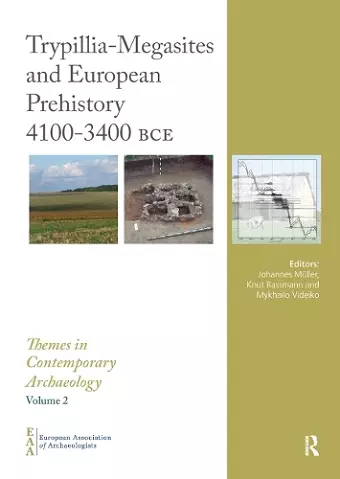Trypillia Mega-Sites and European Prehistory
4100-3400 BCE
Johannes Müller editor Knut Rassmann editor Mykhailo Videiko editor
Format:Paperback
Publisher:Taylor & Francis Ltd
Published:12th Dec '19
Currently unavailable, and unfortunately no date known when it will be back
This paperback is available in another edition too:
- Hardback£165.00(9781910526026)

The Trypillia Mega-Sites and European Prehistory examines the significance of large prehistoric settlements in Ukraine and Moldova, exploring their societal implications and archaeological findings.
Ignored for many years, the archaeology of the Tripillia/Tripolye sites found in modern Ukraine and Moldova contributes significantly to discussions about scale and settlement nucleation in prehistoric Eurasia. The Trypillia Mega-Sites and European Prehistory explores how these massive agglomerations functioned, focusing on the Tripillia group of over 30 'mega-sites' that have been pivotal in understanding early human societies. These sites, some exceeding 250 hectares and containing remains of over 2000 houses, were identified through a multidisciplinary approach involving Soviet and Ukrainian archaeology, including aerial photography and geophysical prospection.
The discovery of these remarkable sites has raised several critical questions regarding their development. Why and under what environmental conditions did the Trypillia mega-sites emerge? How long did they persist? The book also examines whether social or ecological factors influenced this unique social experiment, and whether Trypillia and Uruk represent different concepts of social behavior. The Trypillia Mega-Sites and European Prehistory highlights the importance of recent advancements in excavation strategies and fieldwork methodologies that have allowed researchers to analyze these mega-sites in their spatial and social complexities.
Through the use of high-precision geophysics and systematic field strategies, new empirical data sheds light on the anthropogenic factors influencing steppe development and subsistence practices. The findings suggest that Trypillia mega-sites are an independent European phenomenon, contrasting with urbanism and social stratification observed in Mesopotamia. This book serves as a testament to the methodological progress in European archaeology and the significance of the Trypillia research in understanding prehistoric societal structures.
"Each chapter provides additional information in an orderly way, elaborating on both old and new ideas at the same time, but also leaving enough space for readers to develop their own interpretations ... [The book] presents an array of valuable new data, and advances new theoretical approaches to its interpretation ... The main message is therefore not what has been achieved here—which is, undoubtedly, already significant— but what else might be achieved in future."
Francesco Menotti, University of Bradford, UK
ISBN: 9780367889517
Dimensions: unknown
Weight: 610g
332 pages